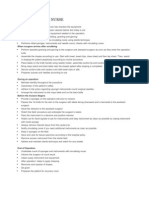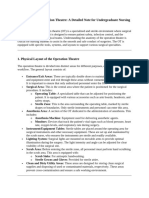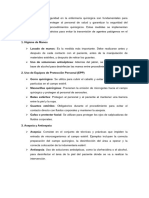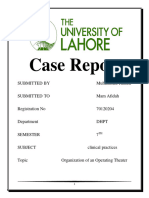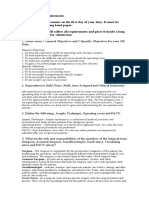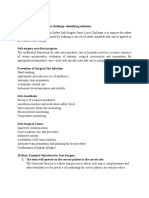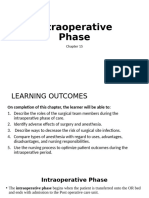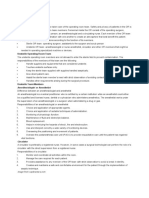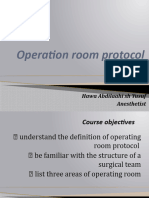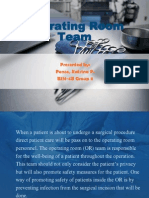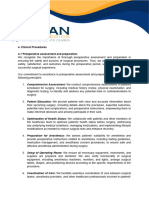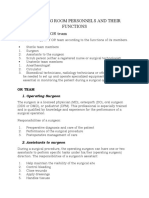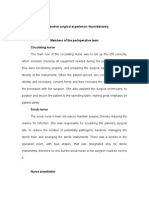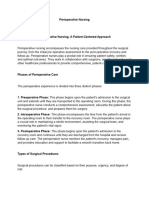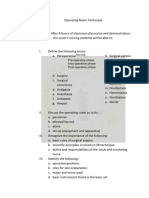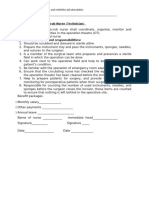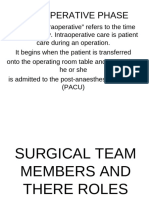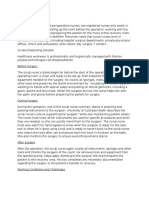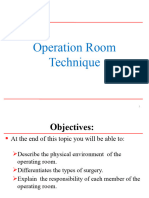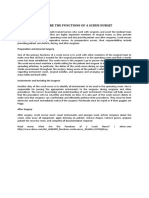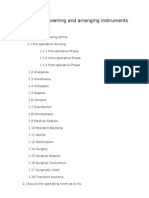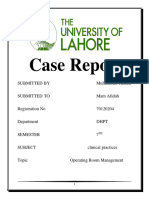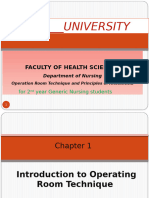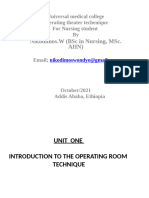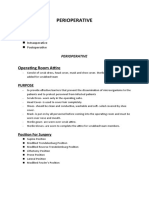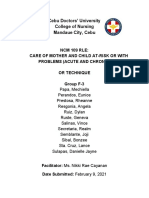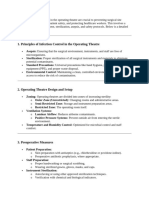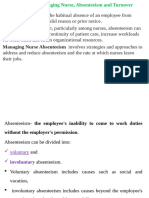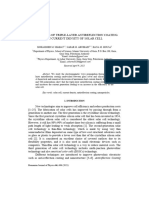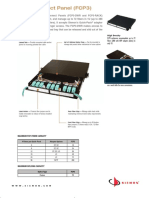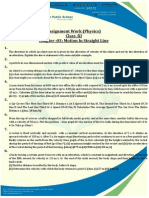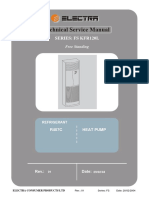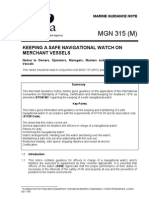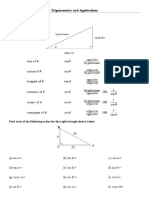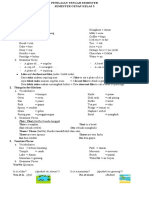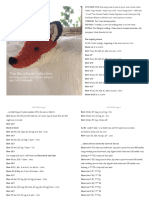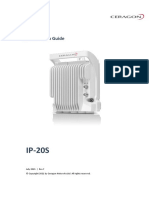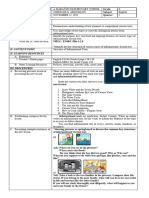U 1
U 1
Uploaded by
melke3323Copyright:
Available Formats
U 1
U 1
Uploaded by
melke3323Copyright
Available Formats
Share this document
Did you find this document useful?
Is this content inappropriate?
Copyright:
Available Formats
U 1
U 1
Uploaded by
melke3323Copyright:
Available Formats
Introduction to the Operation Theatre (OT)
The Operation Theatre (OT), also known as the Operating Room (OR), is a specialized
facility within a healthcare setting where surgical procedures are performed. It is a sterile
environment designed to prevent infection, ensure patient safety, and support the surgical team in
performing medical procedures effectively. The OT is a critical part of the hospital
infrastructure, and its proper management and functioning are essential for successful surgeries
and patient outcomes.
Objectives of the Operation Theatre
1. Provide a Safe Environment: The primary goal is to offer a controlled environment that
minimizes the risk of infection and other complications during surgery.
2. Efficient Surgical Procedure: The OT must be organized and equipped in a way that
allows the surgical team to work efficiently, ensuring that surgeries are completed with
minimal delay.
3. Confidentiality and Privacy: The OT ensures that patient information and procedures
remain confidential.
4. Support for Medical Personnel: The theatre provides a space where surgeons,
anesthesiologists, nurses, and other medical professionals work together as a team.
The Structure of the Operation Theatre
The design of the OT is aimed at reducing the risk of infections and improving workflow. It
typically consists of the following components:
1. Sterile Environment: The OT is maintained under strict aseptic conditions to prevent
infections. The air is filtered, and sterilization techniques are followed for all equipment.
2. Operating Table: This is where the patient lies during the surgery. The table is
adjustable to ensure proper positioning for the surgeon.
3. Lighting System: High-intensity lights are essential for illuminating the surgical site.
The lighting system is usually overhead and adjustable.
4. Surgical Instruments and Equipment: The OT is equipped with a wide range of
surgical instruments, including scalpels, forceps, scissors, and specialized tools
depending on the type of surgery. Additionally, anesthesia machines, monitors, and other
supportive devices are available.
5. Anesthesia Area: A section of the OT is dedicated to the administration of anesthesia,
where anesthesiologists monitor the patient's vital signs and manage sedation.
6. Surgical Scrub Area: This is where the surgical team performs hand scrubbing and
wears sterile gowns and gloves to maintain a sterile environment.
7. Clean and Dirty Zones: The OT is divided into clean and dirty zones to prevent
contamination. The sterile area includes the operating table and surrounding instruments,
while non-sterile areas are for the movement of personnel and storage of non-sterile
items.
8. Air Control Systems: The OT is equipped with air conditioning and ventilation systems
that regulate temperature and humidity and filter out contaminants to maintain air quality.
Roles of Staff in the Operation Theatre
1. Surgeon: The surgeon performs the surgical procedure. They are responsible for the
safety and well-being of the patient throughout the operation.
2. Anaesthesiologist: The anaesthesiologist manages the patient's anesthesia, ensuring they
are safely sedated or under general anesthesia for the procedure.
3. Scrub Nurse: The scrub nurse assists the surgeon by handling sterile instruments and
maintaining the sterile field during surgery. They are responsible for the preparation of
instruments and ensuring their availability during the procedure.
4. Circulatory Nurse: The circulatory nurse manages the overall environment of the OT.
They handle non-sterile tasks such as ensuring the proper functioning of equipment,
documenting the surgery, and communicating with other medical personnel.
5. Surgical Assistant: A surgical assistant (often a resident or another surgeon) may
provide direct support during the surgery, such as holding instruments, suturing, or
helping with other tasks.
6. OT Technician: They are responsible for setting up the OT with the required equipment,
ensuring sterilization of instruments, and providing technical assistance during the
surgery.
Aseptic Technique and Infection Control
Aseptic technique is the set of practices followed in the OT to prevent infection. This includes:
1. Sterilization of Instruments: All surgical instruments must be sterilized before use in
the OT. This is typically done using autoclaves or chemical disinfectants.
2. Hand Hygiene: Proper hand washing and use of hand sanitizers are critical for all
personnel entering the OT. This includes the surgical team, nurses, and any other staff
members.
3. Personal Protective Equipment (PPE): Surgeons, nurses, and other personnel wear
sterile gloves, gowns, masks, and caps to maintain the sterile environment and reduce
contamination risk.
4. Disinfection and Cleaning: The OT is cleaned thoroughly before and after each
procedure. Special disinfectants are used to clean the floors, walls, and surfaces to
remove any microorganisms.
Preparation for Surgery
1. Patient Preparation: Before entering the OT, the patient is prepared by undergoing a
preoperative assessment. This includes checking vital signs, fasting requirements, and
confirming the surgical site. The patient is also given anesthesia as prescribed.
2. Instrument Preparation: The scrub nurse or OT technician prepares and sterilizes all
necessary surgical instruments and arranges them in the sterile field for easy access
during surgery.
3. Sterile Draping: The patient is draped with sterile covers, leaving only the surgical area
exposed. This reduces the risk of infection and ensures a clean surgical field.
Post-Operative Care in the Operation Theatre
1. Monitoring: After surgery, the patient is carefully monitored for any complications
related to anesthesia or the procedure itself. This is done in a recovery room or a post-
anesthesia care unit (PACU).
2. Documentation: Detailed records are kept of the surgical procedure, including the
patient’s condition, the surgery performed, any complications, and the post-operative care
given.
3. Cleaning and Sterilization: Once the surgery is complete, all instruments are cleaned
and sterilized for reuse. The OT is also thoroughly cleaned and prepared for the next
procedure.
Safety Protocols in the Operation Theatre
1. Surgical Safety Checklist: A surgical safety checklist is often used to ensure that all
steps are followed and no critical elements are missed. This includes verifying patient
identity, the surgical procedure, and the surgical site.
2. Emergency Protocols: The OT is equipped with emergency supplies and personnel
trained to handle complications, such as unexpected bleeding, heart or respiratory failure,
and other surgical emergencies.
Conclusion
The Operation Theatre is a specialized, highly controlled environment essential for the safe and
effective performance of surgical procedures. The role of nurses in the OT is pivotal, as they
assist in maintaining the sterile field, ensuring patient safety, and supporting the surgical team.
Understanding the structure, roles, and protocols in the OT is crucial for nursing students, as it
enables them to contribute effectively to the surgical process and ensures better patient
outcomes.
You might also like
- Duties of Scrub Nurse & Circulating NurseDocument2 pagesDuties of Scrub Nurse & Circulating Nurseimafashionista90% (21)
- U 3Document4 pagesU 3melke3323No ratings yet
- Info Mural QuirurjicoDocument8 pagesInfo Mural QuirurjicoElda GuevaraNo ratings yet
- Management of OtDocument5 pagesManagement of OtShafqat UllahNo ratings yet
- Operating Room TeamDocument7 pagesOperating Room TeamFaruqueHossain100% (1)
- OR Duty RLE RequirementsDocument5 pagesOR Duty RLE RequirementsSammy Jr FamilarNo ratings yet
- Operating Room Personnel OrganizationDocument4 pagesOperating Room Personnel OrganizationantihistamiiineNo ratings yet
- Duties of Scrub NurseDocument12 pagesDuties of Scrub NurseckimkimkimNo ratings yet
- WHO Surgical SafetyDocument6 pagesWHO Surgical SafetyMelanie Moises JavierNo ratings yet
- Intraoperative Phase 2021Document62 pagesIntraoperative Phase 2021Jmarie Brillantes PopiocoNo ratings yet
- Or Rle 1-1Document23 pagesOr Rle 1-1Jan Federick Bantay100% (1)
- Intraoperative Care (1)Document33 pagesIntraoperative Care (1)aqatawneh412No ratings yet
- Manajemen PerioperativeDocument34 pagesManajemen Perioperativeyuli arthaNo ratings yet
- What Is Aseptic TechniqueDocument11 pagesWhat Is Aseptic TechniqueMarlchiel Nathan ArregladoNo ratings yet
- Operating Room TeamDocument1 pageOperating Room Teamnursegian13No ratings yet
- Goso: General ObjectiveDocument26 pagesGoso: General ObjectiveGIOVANNIE II JAPSONNo ratings yet
- 16/12/12 Army Force Comphensive Specialized Hospital or Department Standard /sop/ Nursing DutiesDocument7 pages16/12/12 Army Force Comphensive Specialized Hospital or Department Standard /sop/ Nursing DutiesSuzy BaeNo ratings yet
- Settings Up of OTDocument10 pagesSettings Up of OTshivaguruNo ratings yet
- Operating Room LectureDocument12 pagesOperating Room LectureMARY GRACE SABAL100% (1)
- Operetion Theater ProtacoleDocument26 pagesOperetion Theater ProtacoleAyro Business CenterNo ratings yet
- Operating Room TeamDocument18 pagesOperating Room TeamKatrina PonceNo ratings yet
- 12.duties and Responsibilities of OT NODocument6 pages12.duties and Responsibilities of OT NORumela ChakrabortyNo ratings yet
- Clinical Procedures 4.1 Preoperative Assessment and PreparationDocument7 pagesClinical Procedures 4.1 Preoperative Assessment and PreparationJay Hazel MabanoNo ratings yet
- Nurs 470 PeriopDocument98 pagesNurs 470 PeriopchiyumbabeatriceNo ratings yet
- TÉCNICAS DEL AUXILIAR DE ENFERMERÍA EN EL ÁREA DE QUIRÓFANOFrom EverandTÉCNICAS DEL AUXILIAR DE ENFERMERÍA EN EL ÁREA DE QUIRÓFANONo ratings yet
- Operating Room Personnels and Their Functions: Classification of OR TeamDocument3 pagesOperating Room Personnels and Their Functions: Classification of OR TeamRona PieNo ratings yet
- Perioperative NursingDocument50 pagesPerioperative NursingPreeti ChouhanNo ratings yet
- Surgical Condition Notes in Medical Surgical NursingDocument195 pagesSurgical Condition Notes in Medical Surgical NursingjohnuwakijijweNo ratings yet
- Perioperative Surgical Experience: ThyroidectomyDocument5 pagesPerioperative Surgical Experience: ThyroidectomyYemaya84No ratings yet
- Surgical Technologist Job DescriptionDocument2 pagesSurgical Technologist Job DescriptionMeha FatimaNo ratings yet
- RLE Perioperative-NursingDocument9 pagesRLE Perioperative-Nursingpflantolin.2201477.chasnNo ratings yet
- Intraoperative CareDocument2 pagesIntraoperative Carebandna kumariNo ratings yet
- Surgeon Role: RolesDocument3 pagesSurgeon Role: Roleschacha javierNo ratings yet
- MedsurDocument116 pagesMedsurMacy MarquezNo ratings yet
- Operating Room Technique Write Up PAPA SLRCDocument43 pagesOperating Room Technique Write Up PAPA SLRCShane Vlademier ParadoNo ratings yet
- job discrpitonDocument62 pagesjob discrpitonMegersa AleneNo ratings yet
- Intra OperativeDocument25 pagesIntra OperativeJohn PaulNo ratings yet
- Scrub NurseDocument25 pagesScrub Nurseshesham599No ratings yet
- Scrub NursesDocument13 pagesScrub NursesJiovanni WaveNo ratings yet
- Introduction To Or-2Document56 pagesIntroduction To Or-2ermias UmerNo ratings yet
- What Are The Functions of A Scrub NurseDocument24 pagesWhat Are The Functions of A Scrub NurseBrigette Jane Michelle Martil100% (1)
- Intra Op CombinedDocument62 pagesIntra Op CombinedJan Federick Bantay100% (2)
- Final Output of O.R. TechniqueDocument72 pagesFinal Output of O.R. TechniqueNichole Audrey SaavedraNo ratings yet
- Unit 2Document23 pagesUnit 2Abas AhmedNo ratings yet
- U 6Document3 pagesU 6melke3323No ratings yet
- Management of OtDocument4 pagesManagement of OtShafqat UllahNo ratings yet
- Perioperative Nursing: Rachelle M. Ganuelas RN, MANDocument66 pagesPerioperative Nursing: Rachelle M. Ganuelas RN, MANdianahazel_03No ratings yet
- OR Note 1-6Document45 pagesOR Note 1-6johnbrkti1002No ratings yet
- Intraoperative CareDocument5 pagesIntraoperative CareraffineeNo ratings yet
- chapter 1 ORTDocument44 pageschapter 1 ORThailye mitikeNo ratings yet
- Intraoperative CareDocument3 pagesIntraoperative CareMargi Patel100% (2)
- Operating theaterDocument32 pagesOperating theaterTsion MinamoNo ratings yet
- HP ReportDocument70 pagesHP ReportMugesh KannanNo ratings yet
- OT-Visit ReportDocument16 pagesOT-Visit ReportSanjay PatelNo ratings yet
- Perioperative: Operating Room AttireDocument95 pagesPerioperative: Operating Room AttireCristina Tagle GarciaNo ratings yet
- NCM 109 RLE OR TECHNIQUE F 3 Final OutputDocument74 pagesNCM 109 RLE OR TECHNIQUE F 3 Final OutputSunny100% (1)
- U 8Document3 pagesU 8melke3323No ratings yet
- Or Notes UpdatedDocument11 pagesOr Notes UpdatedKc Cabanilla LizardoNo ratings yet
- Case Studies of Postoperative Complications after Digestive SurgeryFrom EverandCase Studies of Postoperative Complications after Digestive SurgeryNo ratings yet
- U 5Document2 pagesU 5melke3323No ratings yet
- data(7)Document1 pagedata(7)melke3323No ratings yet
- NSA ch 10-13Document45 pagesNSA ch 10-13melke3323No ratings yet
- data(4)Document2 pagesdata(4)melke3323No ratings yet
- RomJPhys 66 606Document10 pagesRomJPhys 66 606Madhiyah YahayaNo ratings yet
- Data Analyti - Updated 200723Document2 pagesData Analyti - Updated 200723Herbert AlcatrasNo ratings yet
- Think Out of BoxDocument6 pagesThink Out of BoxPrathik ANo ratings yet
- 1 MCQS: Liquid StateDocument17 pages1 MCQS: Liquid StateRahul NathNo ratings yet
- Fiber Connect Panel (FCP3) : High DensityDocument4 pagesFiber Connect Panel (FCP3) : High DensityAntonio RodriguezNo ratings yet
- Gr.6 Third Periodical Test in MathDocument9 pagesGr.6 Third Periodical Test in MathPein NagatoNo ratings yet
- Assignment Work (Physics) Class:XI Chapter:03: Motion in Straight LineDocument4 pagesAssignment Work (Physics) Class:XI Chapter:03: Motion in Straight Linekarandeep SinghNo ratings yet
- Chapter 7 Applications of DifferentiationDocument14 pagesChapter 7 Applications of Differentiationapi-3728615No ratings yet
- Detail-Material Science NotesDocument276 pagesDetail-Material Science Notessureshbabu7374No ratings yet
- 05 - Technical Manual CCE 45 Au R407cDocument59 pages05 - Technical Manual CCE 45 Au R407cLouis FanuelNo ratings yet
- LC1D25004 Telemecanique LC1-D25004 Contactor ReplacementDocument1 pageLC1D25004 Telemecanique LC1-D25004 Contactor ReplacementFadi NassifNo ratings yet
- MGN 315Document10 pagesMGN 315griffpritchNo ratings yet
- Prog Neurol Psychiatry - 2021 - Sadik - Depression With Psychosis Following Pregabalin DiscontinuationDocument4 pagesProg Neurol Psychiatry - 2021 - Sadik - Depression With Psychosis Following Pregabalin DiscontinuationMarko ZindovicNo ratings yet
- Compressible Compliant and Elastic Gas Pipes: Simulation DescriptionDocument6 pagesCompressible Compliant and Elastic Gas Pipes: Simulation DescriptionhjxyNo ratings yet
- Stardew Valley CC ItemsDocument8 pagesStardew Valley CC Itemsjhen103035No ratings yet
- Ethical Lens Inventory WGU C206 Ethical LeadershipDocument6 pagesEthical Lens Inventory WGU C206 Ethical LeadershipFrancescoNo ratings yet
- Trigonometry and ApplicationsDocument8 pagesTrigonometry and ApplicationsKikiez PathanasriwongNo ratings yet
- Indian Railways-The Backbone of Service SectorDocument10 pagesIndian Railways-The Backbone of Service SectorRadhakrishnan KrishnamoorthyNo ratings yet
- Critique Paper - CovidDocument4 pagesCritique Paper - CovidAliana CorralNo ratings yet
- Physiology of Fish in Intensive Culture Systems - 1996Document246 pagesPhysiology of Fish in Intensive Culture Systems - 1996Wilson RamírezNo ratings yet
- That (Ini/Itu) Benda TunggalDocument1 pageThat (Ini/Itu) Benda Tunggalpram_estiNo ratings yet
- Lesnaya KollektsiaDocument8 pagesLesnaya KollektsiaCarla HegedűsNo ratings yet
- Ceragon IP-20S Installation Guide Rev FDocument109 pagesCeragon IP-20S Installation Guide Rev FarquimidesvalNo ratings yet
- 31 Learners GuideDocument191 pages31 Learners GuideSara KhanNo ratings yet
- Neuro ArtDocument13 pagesNeuro ArtSam JamNo ratings yet
- Catalog ART 2021Document593 pagesCatalog ART 2021Rubens PetrisNo ratings yet
- CO 1 Eng6Document5 pagesCO 1 Eng6Sodonah ArguillonNo ratings yet
- Classification of BurnsDocument18 pagesClassification of BurnsLina DsouzaNo ratings yet
- AN12395Document23 pagesAN12395李一洋No ratings yet
